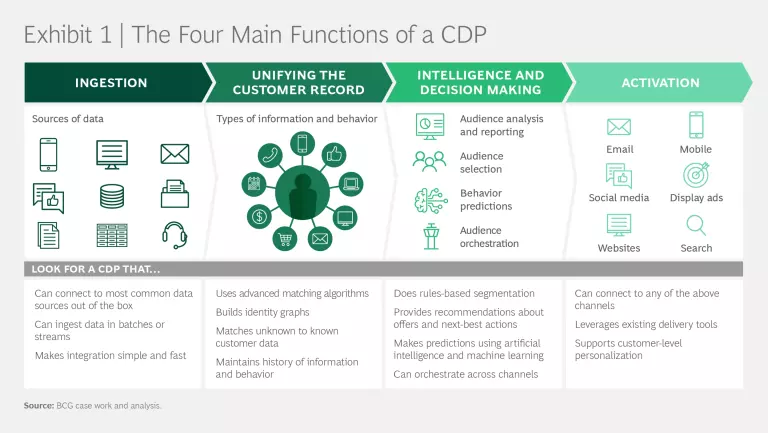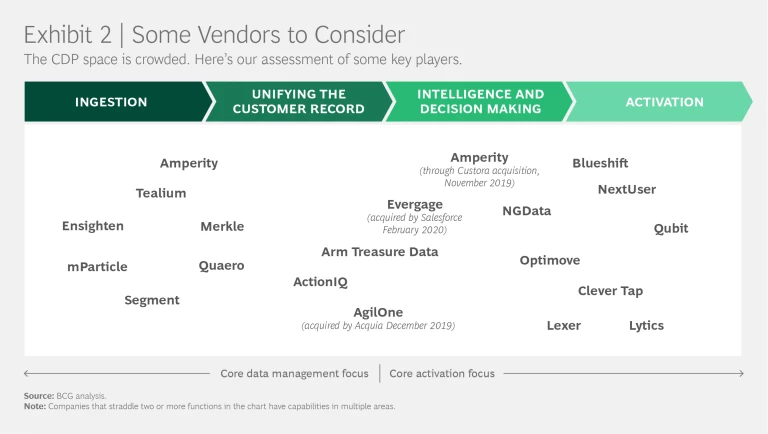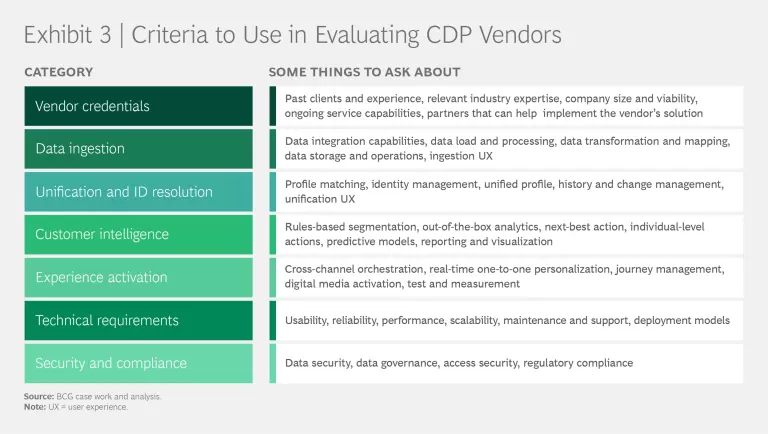Are you frustrated that you can’t activate personalized customer experiences because your customer data is fragmented and spread across dozens of systems? If the answer is yes, you’re not alone.
Instead of waiting for the perfect data lake solution, the vast majority of our clients are exploring customer data platforms (CDPs) to advance their personalization agendas. If you have not done so or have been skeptical about this technology, it’s time to give CDPs a deeper look.
More than a billion dollars have been invested in CDP companies over the past few years, underscoring the interest in the technology. This article distills what we have learned from dozens of client engagements—including those in the financial services, health care, travel, retail, and automotive industries. Individual brands in these industries are using CDPs to deliver highly personalized experiences that are based on a deep, real-time understanding of their customers.
Some examples:
- An automotive company wanted a 10% increase in the number of new car owners who return to the selling dealership for their first service appointment. By combining customer demographic and lifestyle data with vehicle-specific information (including data from telemetry devices), the company plans to deliver personalized communications that highlight the next service the customer will need (an oil filter change, for example) along with accessory recommendations.
- A retail brand set out to increase average customer spending in its stores by 15%. The key was a next-best-action campaign that tapped into a wealth of data—customers’ in-store spending, demographic information, channel preferences, and many other attributes.
- An airline saw a chance to double the sale of complementary services (hotels, rental cars) in the instant after an online booking. To do so, however, it had to increase the effectiveness of its marketing. That meant integrating real-time data from its own website and from travel-agent data feeds and getting a view of customers’ past behavior, such as checked bags and travel frequency.
How are these brands—and many others—getting the most out of their CDP investments? They are clear about the obstacles to personalization that they’re trying to solve, have objectively assessed the capabilities of CDPs, and have developed well-conceived implementation plans.
OBSTACLES TO PERSONALIZATION AT SCALE
Let’s start by talking about why some companies have been disappointed with their personalization outcomes. Personalization initiatives need to surmount three main obstacles:
- Disparate, Disconnected Data Systems. Many companies have dozens of customer data systems that don’t talk to one another. Bringing together all available data, ensuring its quality, and applying good-governance practices to it are complex, time-consuming, and costly IT challenges. Moreover, the sources of data are ever expanding and often include third-party research services that have information on people’s shopping habits and brand preferences. This makes it extremely difficult to arrive at the ideal of a unified customer profile. These unified profiles are valuable because of their richness, which goes well beyond knowing a customer’s contact information and past purchases. A rich customer profile also includes information such as the level of engagement, satisfaction, interests, and online and in-store behaviors. These details require capturing data from multiple sources, devices, and interactions where users’ identities are not always certain.
- A Paucity of In-House Advanced-Analytics Talent. In the war for talent, almost all our clients face challenges in hiring, and retaining, the type of data-engineering and data science staff that is needed to support personalization at scale. Yet without the right combination of skills, brands won’t be able to build, test, and measure the analytics required for accurate and effective personalization. This will limit the value created by their personalization efforts.
- A Lack of Marketing-Technology Integration. Companies need to integrate a broad set of technologies in order to deliver personalization across channels. This can result in a complex and ever-expanding martech stack—and can be very hard to manage. To be sure, some companies have made substantial investments and have pockets of excellence in their martech ecosystems. But the lack of proper integration keeps most companies from delivering a seamless one-to-one customer experience across channels.
THE CAPABILITIES PROVIDED BY CDPS
Most of our clients that are implementing CDPs already have significant data repositories and data infrastructures at their disposal. They often have enterprise data warehouses, data lakes, or master-data management systems. Sometimes they have all three.
CDPs complement these technologies—but not all of them do it in the same way. Many CDPs help by readying data for use, which is the first step in personalization. Others are strongest in activation, the last stage of the process, when personalized messages and offers are actually delivered to customers. (See Exhibit 1.)

Dynamic Data Ingestion and Integration. At the start of any personalization effort, data needs to be assembled in a clean, ready-to-use form. Integrating data into marketing-automation tools, especially when legacy systems are involved, is a difficult and expensive process that requires substantial investment. Doing it manually—as many companies attempt—consumes scarce data-engineering resources. Real-time, contextual data integration to trigger timely customer communications adds another level of complexity.
CDPs address this challenge by offering out-of-the-box ingestion tool sets or connectors, which significantly reduce setup time and investment. Some CDP vendors have more than 50 out-of-the-box connectors as well as adapters that can be configured to address special situations.
To cast as wide a data net as possible, CDPs have back-end infrastructures that allow them to capture semistructured and unstructured as well as structured data. With a software-as-a-service (SaaS) cloud-first model, most CDPs are able to scale very quickly. Their built-in integration layers allow CDPs to accommodate batch and real-time streaming services and connect seamlessly to traditional on-premise, hybrid, or cloud-first business systems. Several leading CDPs are also adept at facilitating or even automating data transformation after ingestion—meaning data can be manipulated, cleansed, and enhanced in the platform with very little prior manual work.
Data Unification and Profile Management. Perhaps the biggest problem in one-to-one personalization is getting a single complete view of the customer. Even when CRM platforms or marketing-automation suites are designated as the single source of truth, the ideal of a “golden record” for each customer has proved elusive.
The ideal of a "golden record" for each customer has proven elusive.
This is one of the most important ways in which CDPs help. After ingesting data from available sources, the CDP determines which customer records belong to the same user (it can do the same with incomplete pieces of data if the data has some identifying characteristic). This process of profile unification (also called identity resolution) results in what we refer to as a 360-degree customer view.
CDPs generally use deterministic matching, building customer profiles on the basis of customer data that unambiguously belongs to one user (like social security numbers, phone numbers, emails, and street addresses). More-robust CDPs supplement that with probabilistic matching, which takes a statistical approach (often leveraging machine learning) to determine the probability that a customer in one system is the same as a customer in another system, even without exact fields in common. When these approaches are combined and customized to a company’s data needs, the process can lead to much higher success in consolidating profiles and greater personalization effectiveness.
The value from this unification is amplified when known customer data is also connected to semiknown data, often from second- and third-party sources that may contain little or no personally identifiable information. And an even more powerful profile can be created through cookie and device ID resolution, which can provide a way of attaching anonymous data, like users’ mobile-browsing activity, to their profiles.
Insights and Decision Making. Today, all CDP vendors provide rules-driven audience segmentation, and most also have out-of-the-box machine-learning (ML) capabilities to apply advanced analytics and predictions to audience selection, personalized communication, and next-best-action recommendations.
There’s an important caveat here, which is that CDPs are unlikely, in most cases, to fill all of an organization’s analytics needs by themselves. CDPs provide a good starting point for capitalizing on customer data, but technology alone isn’t sufficient.
An advanced-analytics team remains critical to capturing the full potential of CDP-enabled personalization. This team of data engineers and data scientists drives the data feature engineering, the ML model development, and the experimentation, testing, and measurement needed to gain a competitive advantage from advanced analytics and insights.
Activation and Channel Orchestration. Marketing-automation tools emerged at a time when email was the new—and, for a while, best—way of reaching customers. Although these tools have added capabilities such as SMS and mobile-app push notifications, they have struggled to keep up with the pace and proliferation of newer channels.
Here, CDPs can help by playing an orchestrator role, activating audiences on any channel and connecting to existing tools and infrastructure. Activation generally happens indirectly, through channel integrations, but some CDPs offer in-platform email and web activation capabilities. This gives organizations an opportunity to leverage the technologies they already have while filling gaps in other areas.
THREE RULES FOR IMPLEMENTING CDPS
There are three keys to success with any enterprise CDP implementation—the right starting point, the right provider, and the right operating model leveraging in-house analytics talent.
A relatively simple use case, if it meets the expected goals can build momentum across the enterprise.
Start with a discrete set of use cases. This is one of the most important factors in getting value from a CDP investment. It’s best to start with a handful of use cases, each focusing on a minimum viable product that can be developed quickly. For example, one apparel company we work with wanted to deliver more consistent personalized product recommendations across its owned channels, including email and websites. A relatively simple use case like this, if it meets the expected goals, can build momentum across the enterprise. The organization sees the value that’s being created and gets excited about learning more, and the buy-in leads to the green-lighting of additional use cases.
The approach of starting with a use case is on the opposite end of the continuum from what some companies are inclined to do. Some use a waterfall methodology, investing tens of millions of dollars in their bids to enable personalization. The investments include time spent identifying the right technology vendors, modernizing each layer of the martech stack, and completing large-scale system and data migrations from legacy platforms. Technology-led approaches like this may involve a year or more of implementation work before they produce any tangible value. And they often fail.
By contrast, the approach that we recommend begins with use cases that can generate returns within a few months and don’t require sweeping changes to a company’s data, analytics, or technology. In this more incremental method, companies unlock value as they mature and scale their personalization efforts—and are able to fund a long-term transformation out of the returns from the use cases. The goal of this stepped approach is to avoid the redundant features, extra integration work, customization costs, training, and overall uncertainty that plague IT initiatives in general and martech implementations in particular.
Understand the vendor landscape. The umbrella term “CDP” is handy, but it can also be misleading. Most CDP developers are innovative, young companies—often still in startup mode—that have had to pick and choose where to focus. (See Exhibit 2.) A CDP vendor that started with a personalization engine may be adept at helping companies deliver data-driven personalized experiences but not as good at providing a 360-degree customer view. Another CDP developer may have begun as a pure-play data analytics platform. It might do a great job of developing insights but be less well suited to orchestrating between, and activating through, different channels.

It’s always important, in technology purchases, to follow a structured vendor selection framework. From our work on many RFPs and implementations, we’ve developed a high-level view of the topics you should consider as you evaluate CPD vendors (see Exhibit 3):
- The Ability to Deliver. By the time you’re meeting with vendors, you should already have an idea of what your initial use cases will be. Ask if the provider has worked on similar initiatives with other companies and get a sense of the scope and complexity of any comparable projects. Don’t hesitate to request customer references, especially if the vendor can point you to someone outside your industry (and therefore not a competitor) whose requirements were similar to your own.
- Technical Strengths. This is where you’ll need to go deepest. Your questions here will depend on which aspect of one-to-one personalization you need the most help with.
If your concerns revolve around data ingestion, the questions that matter to you might be related to the availability of out-of-the-box connectors or the storage of billions of customer events. If unification and profile management are your biggest issues, you might want to know how the provider handles profile matching (through rules or by using artificial intelligence, for instance) and how it thinks about the problem of persistent customer IDs. Companies that need help with insights and decision making or with activation and channel orchestration—the other two possible functions of a CDP—will have a different set of questions. The number and depth of the questions are such that they will probably take multiple meetings to sort out.
- Support and Infrastructure. Questions about reliability and performance are crucial. You may want to know what service-level agreements are available and whether the CDP infrastructure can be deployed in a private cloud as well as in public clouds like Amazon Web Services, Microsoft Azure, and Google.
- Viability and Funding. You want to go with a company that clearly has the history and size to maintain operations unimpeded. Even better would be a company that has continued to invest in order to develop its products and has added to its expertise despite the economic uncertainty of 2020.

Build a high-caliber data-driven marketing team. We’ve already noted that technology will only get you partway down the road to personalization. Indeed, our experience suggests that technology may account for no more than a quarter of the value that companies derive from personalization programs. Far more of the value comes from people and processes.
First and foremost, companies need to build their expertise in data-driven marketing. They need people with expertise in data engineering and data science, software development, martech, and paid media optimization, among other areas.
The composition of the team is critical. Marketing-automation technologies (including CDPs) have changed the required skill sets and removed some of the manual tasks involved in personalization, such as creating target lists and moving files from system to system. Personalization teams nowadays should be focused on decision making and optimization and on adjusting their personalization campaigns with increased effectiveness as the goal.
This type of specialized digital talent is scarce. While many educational institutions have begun to increase their focus on data and analytics, brands cannot simply wait for the education system to fix the talent supply problem. Instead, companies must have a strategy for nurturing this talent internally, by setting up learning-development programs, funding employee-training modules, and creating the personalization experiments that will allow employees with these essential skills to flourish.
Most of our work with brands is in this critical early stage, when the teams are still forming. We train the internal team members, impart essential skills to them, and help the teams expand so that companies can begin the personalization work that lies ahead.
THE FUTURE OF PERSONALIZATION IS HERE
Two critical pieces of one-to-one personalization have fallen into place. The first is the sheer quantity of customer data that’s available, relating to behaviors, habits, and in many cases locations. The second is the potential—easier to realize now than in the past—of giving consumers “surprise and delight” experiences across a variety of channels.
The biggest remaining hurdle is the difficulty of corralling the data so that it can be used to create these personalized experiences and communications.
CDPs offer one way of surmounting that hurdle. Be methodical. Successful implementation requires the identification of promising use cases and an objective assessment of providers’ true capabilities; it also requires an investment in analytics talent. For the brands that do it right, there’s a clear payoff in terms of sales lift, customer satisfaction, and a marketing team that is not shackled by disparate systems and unconnected data.






